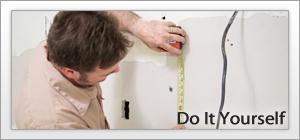HISTORY OF GYPSUM BOARD IN NORTH AMERICA
Modern gypsum board has as its predecessor a product called “Sackett Board,” a composite material that was made of layers of thin plaster placed between four plies of wool felt paper. Sackett Board was patented in 1894 by Augustine Sackett, the man generally considered to be the grandfather of the gypsum board manufacturing industry.
Prior to 1894, gypsum had been used for thousands of years as a building material and as an architectural detailing element. The first use of gypsum in building construction appears to have occurred in 3700 B.C. when the Egyptians used gypsum blocks and plaster applied over woven straw lath in the building of the pyramid of Cheops. As a testimony to the strength and durability of gypsum, some of this construction is still intact and viewable, including walls decorated with murals composed of tinted plaster.
Further evidence of the historical roots of gypsum includes its use in the palace of King Minos of Crete around 1200 B.C. and its presence in alabaster, a form of gypsum used by sculptors during the Middle Ages. In the late 1700s, the French chemist Lavoisier analyzed the chemical make-up of gypsum. His work, and subsequent research by a group of his contemporary chemists, coupled with the discovery and mining of huge reserves of gypsum near Paris, led to the whole-sale use of “Plaster of Paris” as a building material. Plaster of Paris is raw gypsum that is chemically altered by heat to remove much of the water contained in the gypsum molecule and then hydrated to make it use- able as a plastering material. It remains a viable product to this day.
COMING TO AMERICA
At about the same time, Benjamin Franklin brought to America the concept of using gypsum for agricultural purposes. During a trip to France, Franklin had observed farmers using gypsum as a soil 5 additive. He was so impressed by the idea that he began to enthusiastically promote it upon his return to America. The U.S. imported gypsum from Nova Scotia until 1792, when large gypsum beds were discovered in New York State. For roughly the next 100 years, the primary use of gypsum in the U.S. was as a soil additive. During that period, gypsum mines opened in several locations, most notably near Ft. Dodge, Iowa, which eventually boasted the nation’s highest concentration of gypsum facilities in the U.S.
In 1880, Augustine Sackett and Fred Kane conceived the idea of producing a wall- board product from straw, paper, and tar, and designed a machine to manufacture it. Initially, they were able to produce only a highly combustible unusable product, but they persisted, and in 1888 developed “Sackett Board” using plaster of Paris sandwiched between several layers of felt paper. A sheet of Sackett Board was approximately 3/16 of an inch thick and 36 inches square. It had open edges, which tended to erode, and the felt paper did not provide for a satisfactory wall finish. However, it was an excellent base for the application of gypsum plaster and it soon became a replacement product for wooden slat lath.
PRODUCT IMPROVEMENTS
The acceptance of Sackett’s product was helped by simultaneous advancements in gypsum plaster technology – most notably, changes in formulation that improved both the workability and the work- ing time of gypsum plaster. To demonstrate the potential of gypsum plaster, the Alabaster Company used a mixture of gyp- sum plaster and fiber to finish the exterior of the 1893 Chicago World’s Columbian Exposition, thus filling the largest single order of gypsum plaster completed to that date.
In 1894, Sackett patented his manufacturing process for Sackett Board. He opened sev- eral production facilities over the next eight years, and by 1901 he was producing nearly 5 million square feet of board annually.
Sensing the promise for the material, a group of small gypsum producers combined to form the United States Gypsum (USG) Company. By the end of 1902, the company had a total of 37 operations. In 1907, the Canadian Gypsum Company was formed, providing access to gypsum deposits in Nova Scotia.
In 1909, Sackett sold the Sackett Plaster Board Company to USG, where he served as a director until his death in 1914. In 1910, a process for wrapping the board edges was created. This was followed in short succession by the elimination of the two inner layers of felt paper, the replacement of the exterior felt facing with a paper-based covering, and the production of board in standard four-foot widths. By 1916, Sackett Board had evolved into a ready-to-finish panel; within a year, the production of the original product was discontinued.
HELPING THE WAR EFFORT
The demand for gypsum board accelerated during WWI. The first call-up of U.S. troops in 1917 created an urgent need for tempo- rary military housing, both at home and overseas. The military used a variety of building materials to meet this need; however, a barracks fire that took the lives of several servicemen prompted military specifiers to look for naturally fire-resistant materials. Gypsum board met this need and, conse- quently, became the preferred building material for military housing construction.
In the 1920s, several companies joined the gypsum board industry, including CertainTeed Products Company and the National Gypsum Company. Notable tech- nological improvements during the decade included the invention of air-entrainment equipment to make board lighter and less brittle, and the evolution of joint treatment materials and systems.
On April 17, 1930, the Gypsum Association was founded by 12 gypsum producers.
Early on, the Association conducted several fire resistance tests that enabled member companies to use the approved designs, provided that they certified that their products com- plied with the tested materials.
During the 1940s, gypsum wall sheathing and gypsum roof sheathing products were used along with gypsum board in domestic and overseas military construction. By 1945, the military had used approximate- ly 2.5 billion square feet of gypsum board.
The 1950s brought many innovations in gypsum board technology, including the list- ing of additional fire tests, the development of specialized fasteners for the attachment of board, and the use of gypsum board in curved partitions, studless partitions, and sound control systems. Light-weight gypsum lath, plaster, and gypsum board systems fueled a boom period for gypsum products in both residential and commercial con- struction. By 1955, roughly 50% of new homes were built using gypsum wallboard; the other 50% were built with gypsum lath and plaster. The period immediately after World War II also saw the first wholesale marketing of type 'X' gypsum board, which has higher fire-resistance ratings.
USE IN COMMERCIAL CONSTRUCTION
In the 1960s and 1970s, the industry focused on expanding the use of gypsum board in commercial construction, concentrating in particular on apartment building and office tower design solutions. To meet the special- ized demands of high-rise construction, the industry developed innovations such as gypsum board shaftwall systems and movable partition systems, as well as “improved” type X core gypsum products. The industry proudly advertised their use in the John Hancock Center (100 stories) and the Sears (now, Willis) Tower (110 stories), among others.
The past two decades have seen the development and marketing of gypsum board firewall systems to separate individual town- homes and condominiums, and the unlocking of the vast possibilities of the potential for synthetic gypsum.
By the 1990s, entire board production facilities were dedicated solely to using synthetic by- product gypsum for the manufacturing of board. The period also saw a trend toward the development of specialized board and panel products. Using the basic gypsum board theme as a template, industry researchers have continued to create a wide range of proprietary materials to meet modern design and serviceability demands.
From a somewhat humble beginning as a basic building material, gypsum board has become the interior finish material of choice in the North American construction market. The ability of the basic gypsum mineral to adapt to a variety of circumstances has allowed it to be recast and reformulated over many centuries into a variety of differ- ent materials. Adaptive uses for gypsum are still being sought and its future as a building material remains bright.




